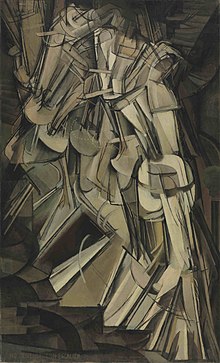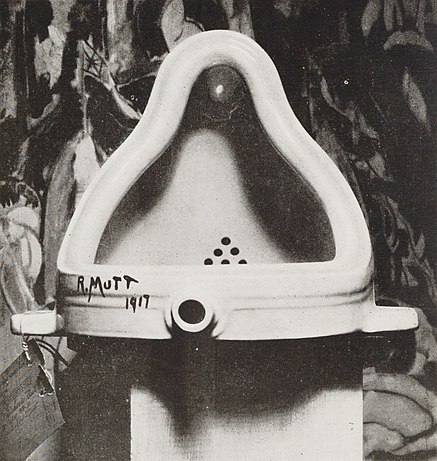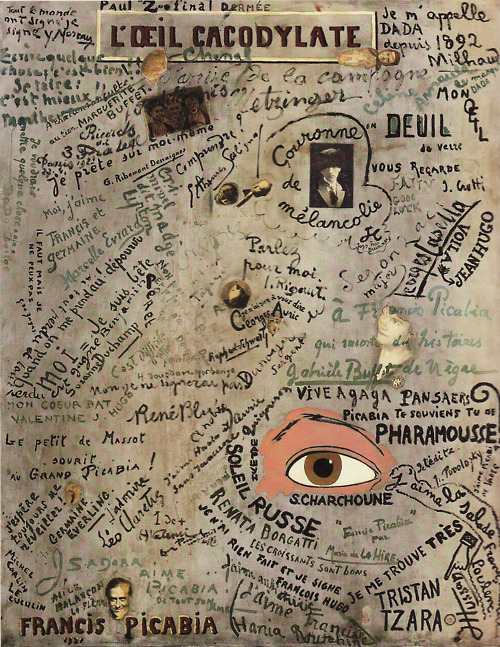
Dada or Dadaism is a movement of culture that begun in Europe. Dada peaked from 1916- 1922 corresponding with WW1. The movement consisted of visual arts, poetry, art theory, theatre and graphic design. The purpose of the movement was to create artwork that ridiculed the modern new world. As well as being anti-war, Dada was also anti-bourgeois and anarchistic in nature.
Dada was an informal movement that protested against the bourgeois nationalist and colonialist interests which most Dadaist believed was the cause of the War. artists such as Hans Richter believed that Dada was not art but rather anti-art because of Dada's lack of traditional aesthetics. Dadaist hoped that through their art they could destroy traditional culture and aesthetics.
Dada was described (by its own artists) as "a phenomenon bursting forth in the midst of the postwar economic and moral crisis, a saviour, a monster, which would lay waste to everything in its path. [It was] a systematic work of destruction and demoralisation... In the end it became nothing but an act of sacrilege."
In Zurich during 1916, Hugo Ball, Emmy Hennings, Tristan Tzara, Jean Arp, Marcel Janco, Richard Huelsenbeck, Sophie Täuber, and Hans Richter, along with others, discussed art and what inspired their art, they then would put on performances expressing these opinion of anti war at the Cabaret Voltaire. Having left Germany and Romania during World War I, the Dada artists found themselves in Switzerland, here they began to rebel against the social and political ideas of the time through abstraction.
The characteristics of Dada
- Never follow any known rules
- Dadaist aimed to provoke an emotional reaction from their viewer.
- Abstraction and Expressionism were the main influences on Dada, followed by Cubism and Futurism.
- There were no limitations as to what mediums dadaists could use, although collage, photo montage and the use of ready made objects became prominently used within the movement.
- The best-known movement Dada was directly responsible for is Surrealism.
Dada self-destructed when it was in danger of becoming "acceptable".
When World War I ended in 1918, most of the Dadaists from Zurich returned to their home countries, and some began Dada activities in other cities. Others, such as Swiss native Sophie Täuber, remained in Zurich.
Using an early form of Shock Art, the Dadaists thrust mild obscenities, scatological humour, visual puns and everyday objects into the public eye. Marcel Duchamp performed the most notable outrages by painting a moustache on a copy of the Mona Lisa.
Dada artists and their work
and "immediate spontaneity" and the 'law of chance'.

Collages made from torn coloured paper were scattered and
then glued as they landed.

Man Ray
was an American artists and modernist that contributed greatly
to the Dada and surrealist movements. he is best known for his Avant-Garde photography.

The Rope Dancer Accompanies Herself with Shadows
Painted in 1916 when Man Ray lived in New York City. After 1918 Ray's began to work more
in the Dada style and used techniques known to Duchamp such as "readymades".
In 1920 Man Ray, Katherine Dreier and Duchamp founded the Société Anonyme, an organisation which in effect was the first museum of modern art in the U.S.
Marcel Duchamp
was a french artist that challenged the conventions of the artistic process and art marketing.
Duchamp early work experimented with post-impressionism, cubism and fauvism.

Jean (Hans) Arp
was part of the founding group of the Zurich Dada artists.
His works were about experimenting with the ideas of "continuous contradiction" and "immediate spontaneity" and the 'law of chance'.

Collages made from torn coloured paper were scattered and
then glued as they landed.

Man Ray
was an American artists and modernist that contributed greatly
to the Dada and surrealist movements. he is best known for his Avant-Garde photography.

The Rope Dancer Accompanies Herself with Shadows
Painted in 1916 when Man Ray lived in New York City. After 1918 Ray's began to work more
in the Dada style and used techniques known to Duchamp such as "readymades".
In 1920 Man Ray, Katherine Dreier and Duchamp founded the Société Anonyme, an organisation which in effect was the first museum of modern art in the U.S.
Marcel Duchamp
was a french artist that challenged the conventions of the artistic process and art marketing.
Duchamp early work experimented with post-impressionism, cubism and fauvism.

Nude Descending a Staircase, No. 2 painted in 1912.
In his studio he mounted a bicycle wheel upside down onto a stool, spinning it occasionally just to watch it. the Bicycle Wheel is considered Duchamp's first of his "Readymades", this particular installation was never submitted for any art exhibition and was eventually lost.
In his studio he mounted a bicycle wheel upside down onto a stool, spinning it occasionally just to watch it. the Bicycle Wheel is considered Duchamp's first of his "Readymades", this particular installation was never submitted for any art exhibition and was eventually lost.


The 'Fountain' is one of Duchamp's most recognisable readymade pieces.
The piece was submitted in 1917 to the Society of Independent Artists and rejected.
Francis Picabia
Pacabia became involved in the Dada movement during
in 1919 in Zurich and Paris before he moved onto to surrealist art in 1921.

Star Dancer on a Transatlantic Steamer 1913 watercolour.

The Cacodylic Eye (L'Oeil cacodylate) 1921
Raoul Hausmann
was a key figure of dadaism in Berlin. his work was made
up of photographic montages (collages).
up of photographic montages (collages).
he was also considered an important influence on the
Avant-Garde movement in the aftermath of World War I.

'Tatlin At Home' Collage 1920
Other works

Leonard Manasseh

Raoul Hausmann

Paula Scher
On the ruins of Dada, a group of Parisian intellectuals built up another artistic movement, Surrealism.
Avant-Garde movement in the aftermath of World War I.

'Tatlin At Home' Collage 1920
Other works

Leonard Manasseh

Raoul Hausmann

Paula Scher
On the ruins of Dada, a group of Parisian intellectuals built up another artistic movement, Surrealism.
